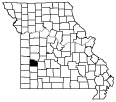Missouri Courthouses
Contact and other information about this county is available on the National Association of Counties website.
Editor’s note
The PDF version of this publication includes illustrations. Select the “Download this publication” button.
 County: Cedar
County: Cedar
Organized: Feb. 14, 1845
Named after: Principal stream in county
County seat: Stockton
First courts of Cedar County met at Crow's Mill in May 1845. In February 1846 the court ordered the laying out of Lancaster the first county seat, in compliance with a plan filed with the clerk and approved by the court. Lancaster's name was changed to Fremont in January 1847 and again to Stockton in February 1859.
During the May court term of 1846, William G. Blake submitted a courthouse plan and was appointed to serve as superintendent of the building. The court appropriated $350, but construction never began. A new County Court, elected in 1846, rented meeting facilities. On Feb. 17, 1847, the court bought a house and lot for $210 from Samuel Moore to use as a temporary courthouse. The house was west of the first considered courthouse site. The court requested possession on or before May 10, 1847.
For the permanent courthouse, the community favored a brick building. The court designated the center of the 220-foot square as the site of the 1852 brick courthouse, the first substantial brick building in town. In May 1852 the court appointed Benjamin H. Cravens superintendent and appropriated $5,500. Contracts were given to Dozier C. Gill, Isaac Ragan and A. M. Long in August 1852 in the amount of $5,500. Cravens soon resigned. Several subsequent superintendents also resigned.
In August a year later, a court ordered that the columns supporting the second floor be changed from round to square. Copper gutters, tin spouts and spout heads were put on in October 1853. The following month the brick and stone work was finished.
Although work was to have been finished by April 1, 1854, the work was not completed by June, endangering what work had been done; the court ordered the bid re-let. M. C. White offered the low bid of $3,000. Except for the railing that enclosed the judges' area, the courthouse was completed Oct. 19, 1855; destruction came by fire in a Civil War incident Oct. 5, 1863. No known illustrations of this building exist.
The clerk recorded no court meetings between May 19, 1863, and March 23, 1864. After the war, the clerk ordered the records of Cedar County, which had been stored in Springfield, to be returned by the first safe means. For four years following the destruction Cedar County had no courthouse.
In May 1867 the court appropriated $10,000 for rebuilding on the original site. B. Davis, sheriff, acted as superintendent. The following day the court approved the plan Davis presented two-story, brick building, 46 by 50 feet, six rooms below, two small rooms and courtroom above. Specifications called for fireplaces in the lower rooms, wall openings for stove pipes and a fireproof roof. Work proceeded quickly, and in December 1867 the court accepted the building (Figure 1).
Figure 1
Cedar County Courthouse, 1867-1940. (Courtesy: State Historical Society of Missouri)
Only two months later, in February 1868, the court issued orders to repair the leaking fireproof roof. In the following months several references indicate continued problems with leaking, and in May 1869 the court appointed James A. Cogle to superintend the repairs and put on an entire new roof, if necessary. Porches were added later. This courthouse continued in use until the 20th century courthouse was built. The court sold the building in 1939 for $100.
Cedar Countians voted down bond proposals to finance a new courthouse in November 1937, but when the opportunity came to apply for federal assistance, they approved a $60,000 indebtedness matched by a Public Works Administration grant of $49,050. James D. Marshall and M. Dwight Brown, an architect-engineering firm of Kansas City, presented a plan to the court.
The first site, with four streets entering in the center of the small block, proved inconvenient, so the city gave the county one block 160 feet square, plus one-half of the block to the west. The site was south of the original square and large enough for sufficient lawn on all sides. The slope of the land permitted a useful ground floor at the rear with full-length windows in one section. Marshall and Brown pointed out that the monolithic cement building would be fireproof in addition to other advantages (Figure 2).
Figure 2
Cedar County Courthouse, 1938-. Architects: Marshall and Brown (Courtesy: State Historical Society of Missouri)
W. F. Edgell and Son, Leavenworth, Kansas, contracted to build the courthouse for $94,104. Hare and Hare, landscape consultants, assisted with the plan. A cornerstone was not possible with the poured construction, so the copper box containing the traditional local memorabilia (coins, papers, pictures, bibles, etc.) was placed in the cement floor of the first story. Dedication took place Jan. 4, 1940. Final costs amounted to $112,600. This was reported to be the first monolithic or architectural concrete public building in the state.
Bibliography
Books
- Abbott, Clayton. Historical Sketches of Cedar County, Missouri. Greenfield: Vedette Printing Company, 1967.
- Abbott, Clayton and Lewis B. Hoff. Missouri History in Cedar County. Greenfield: Vedette Printing Company, 1971.
- History of Hickory, Polk, Cedar, Dade and Barton Counties. Chicago: Goodspeed Publishing Company, 1889.
Newspapers
- Cedar County Republican, June 16, July 14, 21, 28, Aug. 4, 18, 25, Sept. 8, 15, Oct. 6, Nov. 3, 1938; Jan. 12, March 30, April 20, May 11, 18, 1939: Jan. 4, 1940.
Manuscript collections
- Work Projects Administration, Historical Records Survey, Missouri, 1935-1942, Cedar County. Located in Joint Collection: MU, Western Historical Manuscript Collection-Columbia and State Historical Society of Missouri Manuscripts.
Atlases
- Standard Atlas of Cedar County. Chicago: Geo. A. Ogle and Company, 1908.